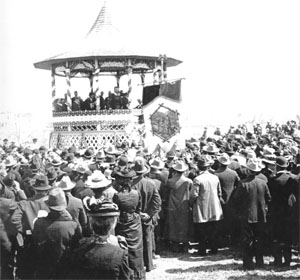Facts & History
Elevation: 3,458 feet Coordinates: (43.301N,-103.825W)
Time Zone: Mountain
Population (2010): 774
On November 2, 1889 South Dakota was admitted to the Union of the United States. As the railroad moved northwest, it crept across the northwest and reached the Cheyenne River.
The Lincoln Land Company, a subsidiary of the Chicago, Burlington and Missouri Railroads, decided that this was the perfect place for the new town which would be the home of the Railroad.
Because the price of the land set by the owner, Mr. Fitch was so high, the land company was forced to purchase land south of the river. In the spring of 1890, the depot and railroad yards were built and the town of Edgemont was born. The name Edgemont was derived from the fact that the town was located on the southern edge of the Black Hills Mountains.

The first ten years of Edgemont’s history recorded rapid growth. As this was expected to be the manufacturing city of the new “Northwest”, a 14 mile irrigation canal was constructed, houses were built in Edgemont proper and a quarry was built at the mouth of Red Canyon for the manufacturing of grindstones.

The first church erected in town was the Presbyterian Church built around 1892. It was located in the area now occupied by the United Church. The Methodist Church followed in Cottonwood in 1896. The Catholics bought the La Casa Opera House and remodeled it into a church. In 1898, a large stone school was erected to replace the smaller school due to an enrollment of 81. In the late nineties, Edgemont experienced serious trouble. Eastern Capitol was no longer available, the dam at the Cheyenne River washed out, the Edgemont Company went broke, much of the business district was wiped out due to fire and an outbreak of typhoid and smallpox hit the area, all of which was overshadowed by the great depression.
At this time, Edgemont became a railroad and cow town as the regional economy was vested in livestock. In 1903, Edgemont was host to President Teddy Roosevelt. From the bandstand that still stands in the city park, President Teddy Roosevelt addressed the crowd. From his vantage point, the President was able to see a wagon covered with a canvas top; a chuck wagon. As the story goes, the president went out to eat and visit with the riders at the chuck wagon while his party dined with the ladies at the stone block building which stood until late 2002.

Since then, Edgemont has seen numerous times of change; from economic prosperity to decline. At present, Edgemont is the home of the south end (mile marker 0.0) of the Mickelson trail, a bike/horse/hiking trail created from the track site of the old railroad stretching from Edgemont to Lead.
Edgemont remains primarily a ranch town and the home to the Edgemont Depot of the BNSF Railway. (extracted from Edgemont Centennial Book 1890-1990)






